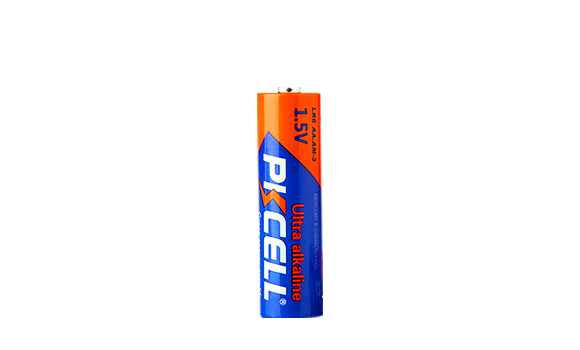르베이비란?
르베이비는 전 세계 엄마들이 건강하고 똑똑한 아기를 출산할 수 있도록 돕는다는 사명을 가진 독일 브랜드입니다. 산모, 유아 및 부모와 자녀를 위한 일련의 제품을 생산하기 위해 최선을 다하고 있습니다.
르베이비는 산모 및 유아 업계의 중상급 브랜드입니다. 설립 이래 고품질의 제품과 더 나은 서비스로 사용자를 대하기 위해 노력해 왔으며 대다수의 사용자로부터 깊은 사랑을 받고 있습니다. 더 많은 사람들이 이 제품을 더 편리하게 구매할 수 있도록 르베이비는 인터넷에 여러 공식 온라인 스토어와 플래그십 스토어를 개설하여 소비자에게 더 많은 선택권을 제공했습니다.
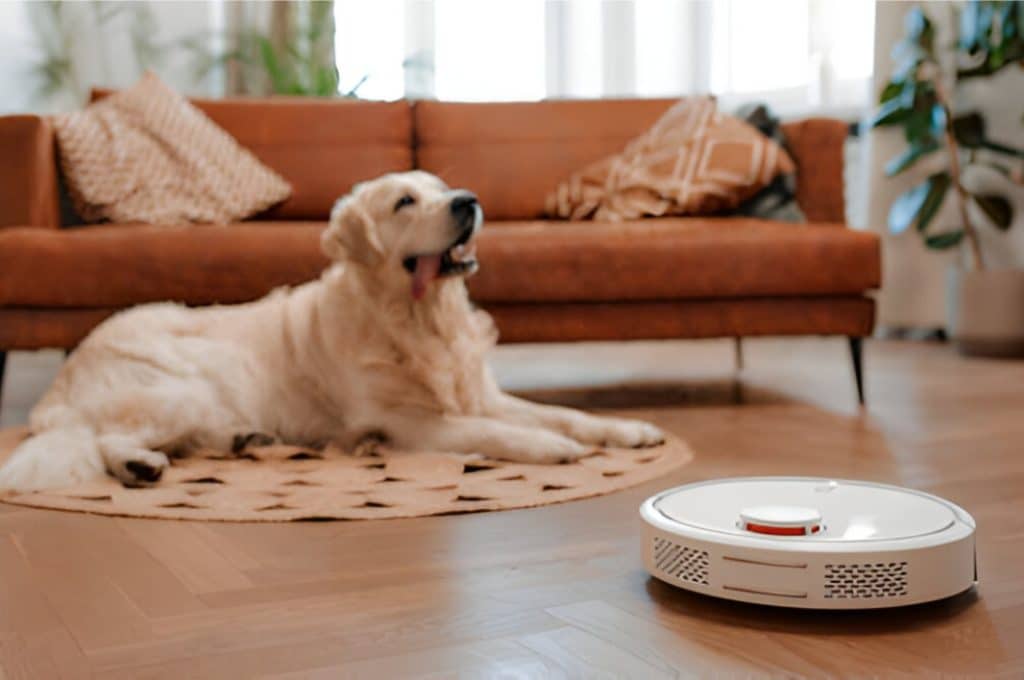
도전 과제
전동 분유 젖병은 르베이비가 우유를 넣고 계량하는 데 도움을 주기 위해 새롭게 개발한 제품입니다. 이전 배터리 공급업체는 배터리 전력, 용량 및 무선 충전 모듈 지원 측면에서 LeBaby의 전기 분유병의 요구 사항을 충족하지 못했기 때문입니다. 르베이비는 여러 리튬 배터리 공급업체를 비교한 끝에 이 기술적 문제를 해결하기 위해 전기 분유 젖병용 배터리 공급업체로 유파인을 선택했습니다.

모터 멈춤
배터리 PCB의 불충분한 보호 지연으로 시동 모터 고장으로 이어짐

모터 멈춤
배터리 PCB의 불충분한 보호 지연으로 시동 모터 고장으로 이어짐

모터 멈춤
배터리 PCB의 불충분한 보호 지연으로 시동 모터 고장으로 이어짐
솔루션 찾기
유파인의 배터리 엔지니어들은 제대로 작동하지 않는 르베이비의 전동 분유병을 받은 후 문제 원인을 분석하고 기술팀과의 연구 회의를 거쳐 이 제품에 적합한 리튬 배터리 솔루션을 특별히 맞춤 제작했습니다.
1. 시동 시 전기 우유병이 멈추는 현상의 주된 이유는 모터가 시동되는 순간 배터리 PCB가 보호 조치를 취하여 배터리가 계속 출력되지 않아 모터가 멈추기 때문일 수 있습니다.
유파인의 배터리 엔지니어는 오실로스코프를 사용하여 배터리를 테스트하고 최대 피크 작동 전류와 피크 시간을 캡처했습니다. 그런 다음 전류와 피크 시간을 비교하여 배터리 보호 회로 파라미터를 결정했습니다. 구성을 수정한 후 모터가 더 이상 걸리지 않았습니다.
2. 전기 분유 병의 배터리 수명이 부족한 주된 이유는 배터리 코어의 속도, 즉 방전 용량 설계가 불합리하기 때문입니다. 전기 분유가 작동 중일 때 전류가 너무 크고 배터리 속도 설계가 충분하지 않기 때문에 전압이 더 많이 떨어지고 전압이 모터의 작동 전압보다 낮아지고 모터가 작동을 멈춥니다. 그러나 배터리에는 여전히 사용할 수 없는 20% 이상의 용량이 있습니다.
따라서 유파인의 배터리 셀 엔지니어들은 3C의 속도로 방전하면서도 동일한 용량을 유지할 수 있는 배터리를 설계했습니다. 일련의 테스트 끝에 배터리 방전의 전체 작동 시간이 50% 이상 증가했습니다. 늘어난 배터리 속도 덕분에 비용을 늘리지 않고도 배터리 에너지를 더 효율적으로 사용할 수 있게 되었습니다.
3. 무선 충전 속도가 너무 느립니다. 주된 이유는 무선 충전 작동 속도가 너무 작기 때문입니다. 이전 배터리는 0.2C 충전만 가능했기 때문에 충전 회로는 충전하는 데 5시간 이상 걸리도록 설계되었습니다. 유파인이 개선한 리튬 배터리는 1C~2C로 충전할 수 있습니다. 충전 모듈을 교체하면 1~2시간이면 배터리를 완전히 충전할 수 있습니다.
관련 제품
-
AAA vs AA Battery: Comprehensive Comparison Guide
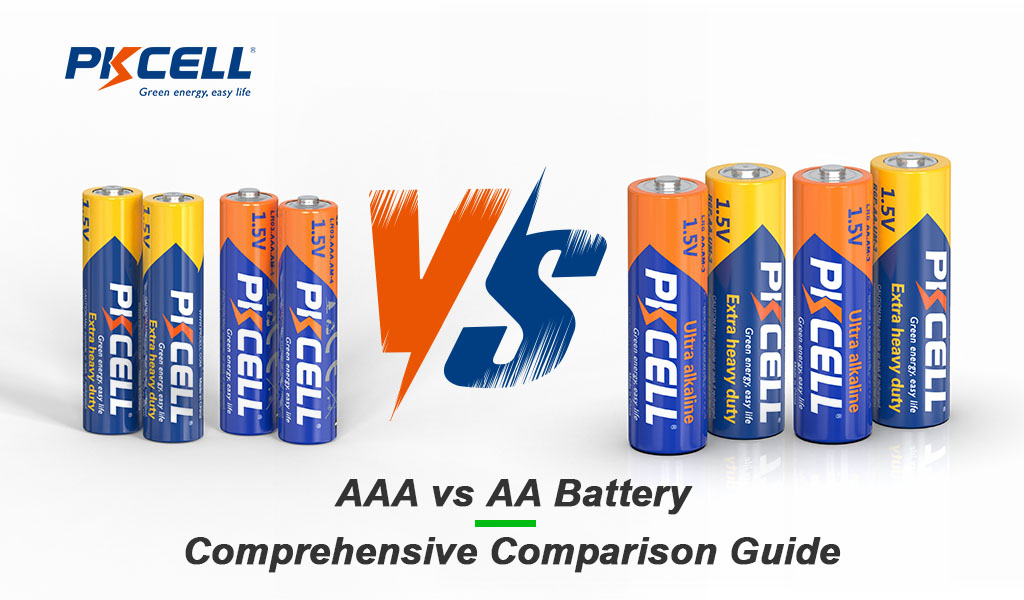
주요 특징
- AA and AAA batteries are both cylindrical primary (single use) or secondary (rechargeable) cells, widely used in consumer electronics.
- AA batteries are larger (14.5mm diameter, 50.5mm length) than AAA batteries (10.5mm diameter, 44.5mm length), fitting devices with more space.
- AA batteries typically have higher capacity (1000-3000mAh) compared to AAA batteries (500-1200mAh), supporting longer runtime in medium-power devices.
- Both share similar nominal voltages (1.5V for alkaline, 1.2V for NiMH rechargeables) but differ in power output suitability.
- AA batteries suit devices like remote controls and toys; AAA batteries are ideal for smaller gadgets like TV remotes, wireless mice, and portable flashlights.
소개
AA and AAA batteries are among the most common power sources in household and portable electronics, from remote controls to digital cameras. While they may look similar at first glance, their differences in size, capacity, and performance make them suited for distinct applications. For consumers, product designers, or buyers, understanding these differences is key to choosing the right battery for a device—ensuring optimal performance, avoiding compatibility issues, and balancing cost and efficiency. This guide breaks down the core distinctions between AA and AAA batteries to help you make informed decisions.
Understanding AA and AAA Batteries
Both AA and AAA batteries are cylindrical, standardized cells used to power low-to-medium energy devices. They are available in two main types: single-use alkaline (disposable) and rechargeable NiMH (nickel-metal hydride). Their names (AA, AAA) derive from size standards set by industry bodies, with “AAA” indicating a smaller form factor than “AA.” Choosing the wrong size can lead to poor fit, reduced device performance, or even damage—for example, a loose AAA battery in an AA-sized compartment may rattle, causing intermittent power loss. While their chemical compositions (alkaline or NiMH) are often similar, their physical and performance traits diverge significantly.
The Basics of AA Batteries
AA batteries are the larger of the two, with a standard diameter of 14.5mm and length of 50.5mm. They are versatile, available in both alkaline (single use) and NiMH (rechargeable) variants.
Alkaline AA batteries typically have a nominal voltage of 1.5V, while rechargeable NiMH AA batteries operate at 1.2V. Their capacity ranges widely: alkaline AA batteries usually offer 1000-2700mAh, while high-quality NiMH versions can reach 2000-3000mAh. This higher capacity makes them ideal for devices that draw moderate power over extended periods, such as toys, portable radios, electric shavers, and digital cameras.
Click Here to quote for AA Alkaline batteries
Click Here to quote for AA Ni-MH batteries
The Basics of AAA Batteries
AAA batteries are smaller, with a diameter of 10.5mm and length of 44.5mm, about 30% smaller than AA batteries. Like AA batteries, they come in alkaline (1.5V) and NiMH (1.2V) options.
Their capacity is lower due to their smaller size: alkaline AAA batteries typically range from 500-1000mAh, while rechargeable NiMH AAA batteries offer 600-1200mAh. This makes them better suited for low-power, compact devices where space is limited, such as TV remotes, wireless computer mice, small flashlights, and portable gaming controllers.
Click Here to quote for AAA Alkaline batteries
Click Here to quote for AAA Ni-MH batteries
Key Differences Between AA and AAA Batteries
The primary differences lie in size, capacity, and suitability for specific devices—traits that directly impact how they perform in real-world use.
물리적 크기 및 호환성
Size is the most obvious distinction. AA batteries’ larger dimensions (14.5mm x 50.5mm) require more space in device compartments, while AAA batteries (10.5mm x 44.5mm) fit into slimmer, more compact designs.
Device manufacturers design battery compartments to match specific sizes, so an AAA battery cannot reliably replace an AA battery (it will be too small, leading to loose connections), and vice versa (an AA battery will not fit into an AAA compartment). Always check the device manual for size requirements.
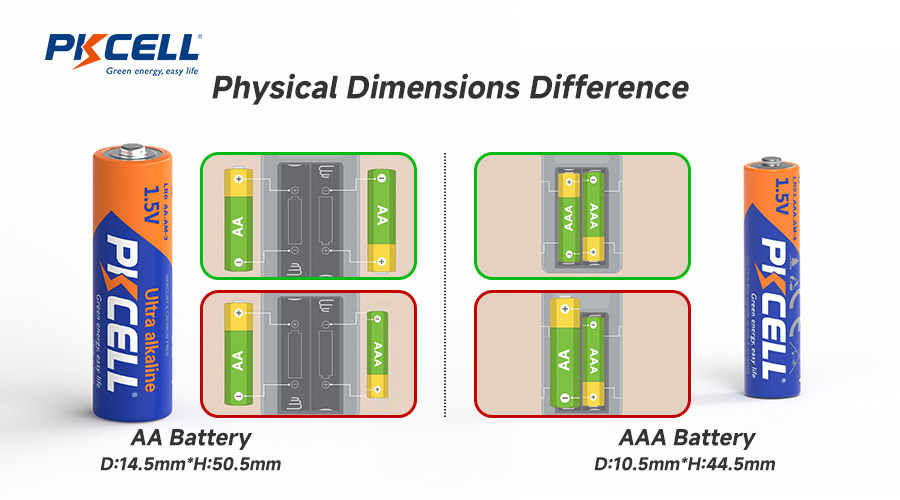
용량 및 에너지 출력
AA batteries’ larger volume allows them to store more energy. For example, a high-capacity alkaline AA battery (2700mAh) can power a toy car for 4-6 hours, while an AAA battery (1000mAh) in the same device would last 1-2 hours.
Discharge rates (how quickly energy is released) are similar for both when chemistry is the same (e.g., alkaline or NiMH), but AA batteries’ higher capacity means they sustain power longer in devices with steady energy demands (like a portable fan), whereas AAA batteries excel in devices with brief, low power uses (like a remote control button press).
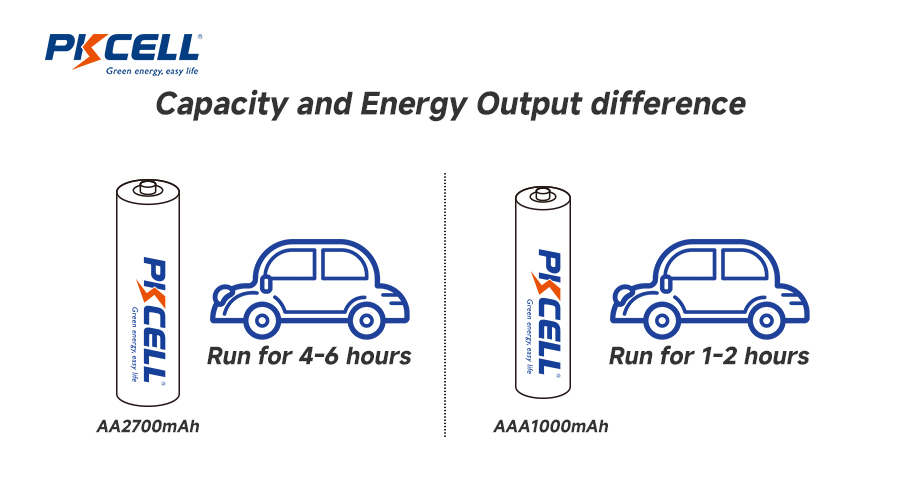
Comparison Table: AA vs AAA Battery
기능 AA 배터리 AAA Battery 지름 14.5mm 10.5mm 길이 50.5mm 44.5mm 공칭 전압 1.5V (alkaline); 1.2V (NiMH) 1.5V (alkaline); 1.2V (NiMH) 용량 범위 1000-3000mAh 500-1200mAh 일반적인 방전 속도 Moderate to high Low to moderate 공통 애플리케이션 Toys, cameras, shavers Remotes, mice, small flashlights 각 배터리 유형의 장단점
Pros and Cons of AA Batteries
– Pros: Higher capacity for longer runtime; versatile for medium-power devices; widely available; rechargeable versions offer cost savings over time.
– Cons: Larger size limits are used in compact devices; alkaline variants generate more waste when disposed of; heavier than AAA batteries.
Pros and Cons of AAA Batteries
– Pros: Compact size fits small devices; lightweight; sufficient for low-power needs; affordable and easy to find.
– Cons: Lower capacity leads to shorter runtime; not suitable for high-power devices; rechargeable versions may have shorter lifespans than AA NiMH.
결론
AA and AAA batteries are foundational to everyday electronics, but their differences in size and capacity make them far from interchangeable. AA batteries excel in medium-power, space-available devices, offering longer runtime, while AAA batteries are the go-to for small, low-power gadgets. When choosing, consider your device’s size, power demands, and whether rechargeable (for frequent use) or disposable (for occasional use) options make more sense.
Why Choose Pkcell as Your AAA and AA Batteries Supplier?
PKCELL is a leading B2B battery supplier with over 20 years of experience, offering high-quality AAA and AA batteries for a wide range of industrial and commercial applications. Our AA and AAA batteries, available in both alkaline and rechargeable NiMH versions, deliver reliable, long-lasting performance for everyday and professional devices. With advanced manufacturing, strict quality control, and certifications like ISO9001, CE, and RoHS, PKCELL ensures consistent product quality and dependable supply.
Reach out to us today for custom solutions and bulk pricing.
자주 묻는 질문
Can I use AA batteries in a device designed for AAA?
No. AA batteries are larger than AAA batteries and will not fit into AAA compartments, potentially damaging the device or causing safety risks. Always use the size specified by the manufacturer.
Are rechargeable AA and AAA batteries worth it?
Yes, if the device is used frequently. Rechargeable NiMH AA/AAA batteries can be reused 500-1000 times, reducing long-term costs compared to disposable alkaline batteries. They are ideal for high-use devices like toys or cameras.
Do AA and AAA batteries have the same lifespan?
Alkaline AA batteries generally last longer in storage (5-10 years) than alkaline AAA batteries (3-7 years) due to their larger capacity. Rechargeable NiMH batteries have similar shelf lives (3-5 years when stored properly) but self-discharge more
자세히 알아보기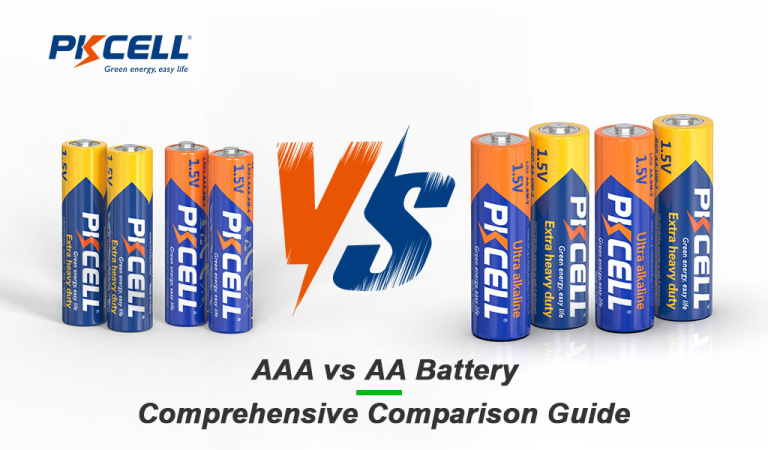
-
USB-C 리튬 충전식 배터리 1.5V D 7400mWh
- 최대 정전류 충전 전류 : 500mA
- 최대 연속 방전 전류 : 2000mA
- 주기 수명: 300+
- 작동 온도: -20~60°C
자세히 알아보기
-
USB-C 리튬 충전식 배터리 1.5V C 5000mWh
- 최대 정전류 충전 전류 : 500mA
- 최대 연속 방전 전류 : 2000mA
- 주기 수명: 300+
- 작동 온도: -20~60°C
자세히 알아보기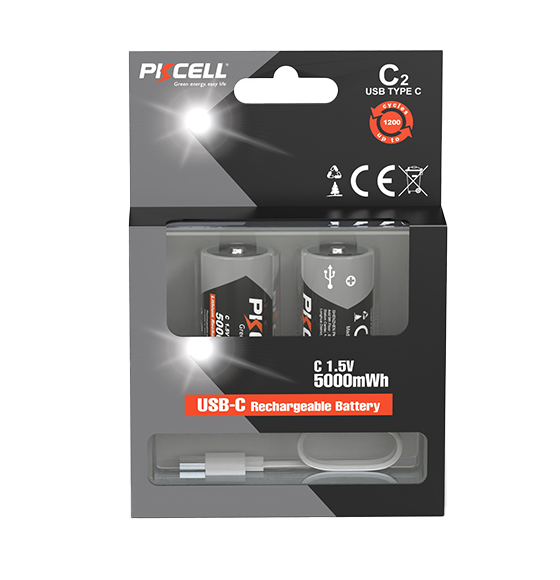
도전 과제가 있으신가요?
나만의 배터리 솔루션을 찾아보세요!
연락하기
-
 전화86-755-86670609
전화86-755-86670609 -
 회사 주소9층 , 블록 B, 홍룽위안 북역 센터, 328호, 민탕 로드, 롱화구, 롱화구, 중국, 518110, 선전,518110
회사 주소9층 , 블록 B, 홍룽위안 북역 센터, 328호, 민탕 로드, 롱화구, 롱화구, 중국, 518110, 선전,518110

 USB 충전식 리튬 배터리
USB 충전식 리튬 배터리
